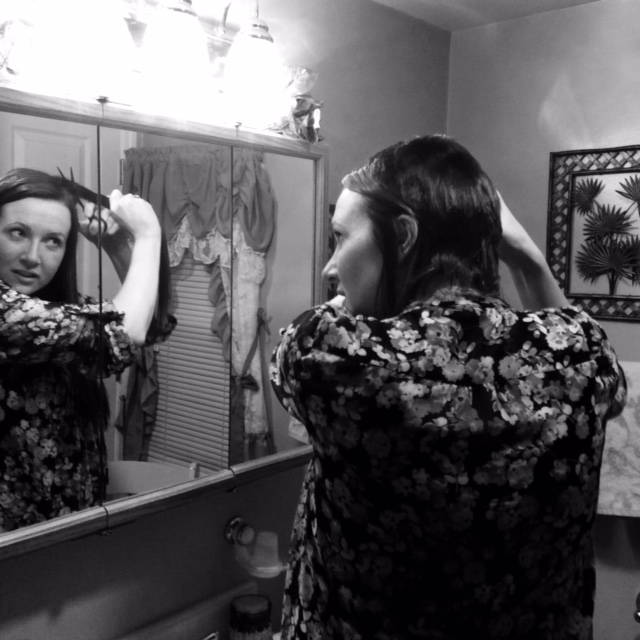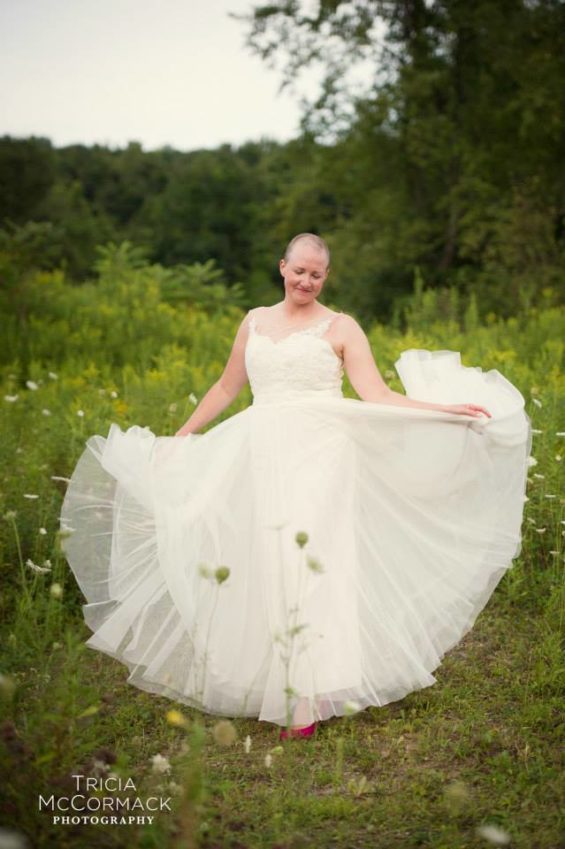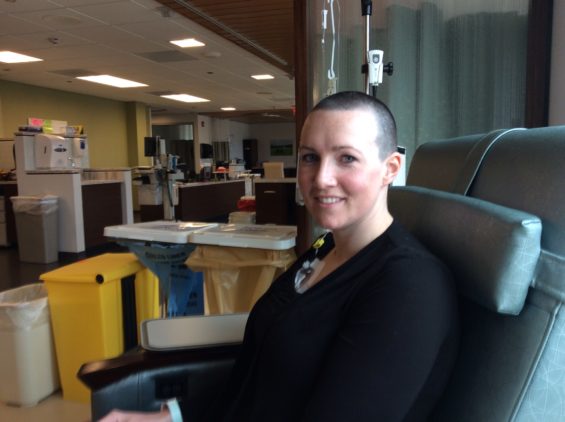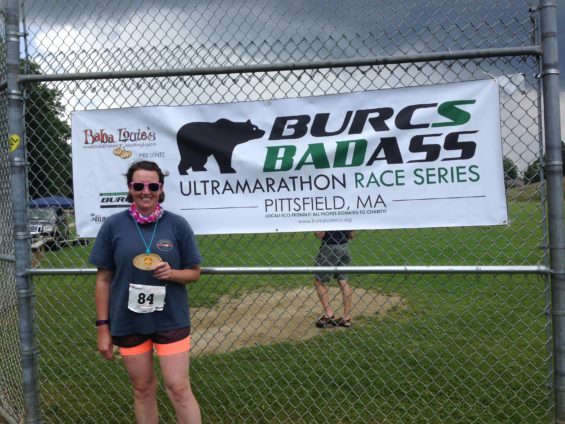Fast Track: Michelle Murphy Outpaces Cancer and Finds a New Passion in Ultra Running


Michelle at her wedding, after she took off her wig prosthesis (photo by Tricia McCormack)
Michelle Murphy was at the office when she got the call. The lump she’d found in her left breast—the one she’d ignored for nearly three months—was triple-positive, stage 2A cancer. She swallowed against the burning sensation of tears in her throat and eyes. Michelle was 28.
“You just feel hollow—there’s this emptiness. It’s all worst-case-scenario thinking,” she recalls of the earliest days. In the midst of starting a new career in social media and planning a wedding, she was thrown into the fast-paced, life-or-death decision making of oncology. Over the course of six weeks, Michelle learned the “whole new language” of cancer treatment, conduced almost daily research on her symptoms and options, kept detailed track of every communication in an enormous binder, and made decisions on topics she never thought she’d have consider before the age of 30, like freezing her eggs in case the drugs affected her fertility.
After those whirlwind weeks, the two-year treatment began. Michelle credits her oncologist, Dr. Trevor Bayliss, himself a cancer survivor, with instilling confidence and guiding her through the process, and her “angels,” the oncology nurses at Hillcrest Center, with helping her to pull through. Several of her friends and her now-husband, Peter Nugent, a painting contractor and wood floor refinisher, and his family pitched in with everything from cooking extra meals to moral support and driving Michelle to and from appointments.
There were many, over the course of 18 months. First came neoadjuvant chemotherapy and targeted drugs—given prior to surgery to shrink the tumor, which had metastasized and redirected blood flow to itself. These would be followed by surgical removal of the tumor and 29 rounds of radiation, plus additional chemo treatments—28 rounds in all.

Michelle during chemo treatment
Being on the chemo floor with other sick and often dying patients meant the shadow of Michelle’s own mortality always hovered nearby. That and the side effects—nausea; a flulike feeling of weakness, sickness, and cold; fatigue; a host of skin issues—were debilitating, yet Michelle opted to continue working. Then a unique form of cognitive impairment often referred to as chemo brain became her nemesis.
“It’s really hard to work around. You have no concentration, and there’s this weird short-term memory loss. I would lose my focus in the middle of writing an e-mail,” she explains. “I was forgetful all the time, and I’m not like that. I’m really organized, but I found myself late to meetings.” Michelle, who had struggled with depression as a teen, found herself constantly tested. She threw herself into her work and planning her wedding to stave off negative thoughts.
Still, the hardest moments were often the smaller ones. Physical fluctuations—weight, complexion, appearance—forced Murphy to confront a changing perception of her own beauty. Then came many women’s ultimate nightmare: “I was going to a bald bride.” Knowing that watching her 22-inch hair accumulate on her hairbrush or in her shower drain would be even more traumatic, she made light of the situation by throwing a hair-shaving party.

Michelle’s hair-shaving party
The unexpected, alienesque effect of losing her eyebrows and eyelashes gave her another moment of pause, but the self-pity didn’t last long. Realizing she had to “get the hell over it,” Michelle traveled to New York City to have a custom wig prosthesis made, and signed up for the American Cancer Society’s Look Good, Feel Better program, which teaches thousands of women per year—including many makeup aficionados like Michelle—how to apply cosmetics during different stages of treatment to help boost their confidence.
About halfway through treatment, Michelle hit another roadblock: the chemo drugs were damaging her heart. She was forced to take six weeks off—a seeming lifetime in cancer treatment—to recuperate. She asked her doctor how to prevent future damage, and he suggested she exercise—not just a stroll around the block, but moderate- to high-intensity workouts that get the heart pumping.
She also thought back to the 2013 documentary Desert Runners, which she had watched during one of her chemo-recovery movie binges. The film chronicles a group of nonprofessional runners as they compete in ultramarathons—races that often go hundreds of miles beyond the standard marathon distance of 26.2 miles.
She was online not long after, putting her research skills to use in finding local running and ultra-running organizations, and began self-training. Despite the pain and difficulty of starting over, and in a body that had taken some hard knocks over the course of 18 months, Michelle never thought of quitting. “I like being able push myself beyond what I think I can do,” she says. “Cancer treatment taught me to be fearless.” It also felt like a way to reclaim some of the time she lost during treatment, and a healthy outlet for working out the stress that had been a constant part of her life for nearly two years. She started training—entirely on her own.
On June 17, 2016, her thirtieth birthday, Michelle had her final chemo treatment. She celebrated with a nap, followed by dinner with her husband. The following day, they left for a brief family vacation in the Adirondacks, and upon her return, Michelle turned up the heat on her ultra running.
On August 6, she competed in her first race, the Sweltering Summer Ultra & Marathon, hosted by Berkshire Ultra Running for Community Service, with event proceeds benefitting Moments House in Pittsfield. Her goal was to do one mile for each of her 28 chemo infusions. She came up a little short at 21.32 miles, but jokes, “I felt like a Honda from 1997—reliable, consistent. There were some Teslas and Corvettes there, but my goal was to be as good as I could be.”

Michelle finishes the Sweltering Summer Ultramarathon
Michelle will compete in a few more regional races, but is laser focused on her next big goal: the Roving Race, an ultramarathon through the arid steppes, deserts, and grasslands of Patagonia in November 2017. She’s looking for a coach to help take her training to the next level, and sponsorship wouldn’t hurt, either: at 250 km and $3,800, the race isn’t for the faint of heart or slim of wallet. Murphy would like to make her participation into a fund-raising event for Hillcrest Cancer Center. “I want to give back to them for all they’ve given to me,” she says.
Michelle, who has also just started a new job as sales manager with the Red Lion Inn in Stockbridge, is hard at work on a blog, ReallyMichelle.com, which she hopes will be a resource of tips, experiential writing, and advice for other young women facing a cancer diagnosis. She also wants it to be a place where women can connect to share information and support each other through the process.
“The average American woman’s risk of being diagnosed with breast cancer at the age of 30 and younger is 1 in 227. That’s .44 percent,” she explains. “However small a statistic, it’s an enormous number when you take into account the entire population of American women under 30 years old. There’s a ‘Michelle’ getting diagnosed right now as we speak, and if I can help her in any way, that’s why this blog exists. Breast cancer isn’t just something to worry about at 40 or 50 or heading into menopause. And it isn’t necessarily a death sentence. But it’s imperative that women, even under 30, check themselves and take action if something isn’t right.”
When asked how she has managed to stay, as Nugent puts it, “infuriatingly positive,” Murphy tucks her pixie-cut brown hair behind her ears and thinks for a moment. “I don’t know where that comes from,” she says. “But I don’t live in the what-ifs. I try to hold on to the good in everything. It’s easy to focus on ‘Why me?’ but really the question is ‘Why not me?’ I’m ready to take on the responsibility of being the voice of the under-30 woman diagnosed with breast cancer.”
An abbreviated version of this story first appeared in the October 2016 issue of Berkshire HomeStyle.